Noodles are a staple food in Japan. There are thousands of noodles that differ from the West, both in the composition of the dough and in the ingredients of the dish. In this article, we are going to look at different types of Japanese noodles.
Despite mentioning different types of noodles, Japan is famous for making its own pasta in restaurants, so the taste and type kind of changes from region and restaurant, providing original and indescribable types.
Throughout the article we will highlight one of the keywords for each type of pasta, by clicking on it, you will be redirected to an article that talks more about that particular type of pasta.
Table of Content
Ramen or Lamen - Noodle Soup
Ramen It is a simple dish that consists of a noodle soup with a variety of ingredients and flavors. Usually, restaurants make their own noodles used in the dish, which closely resembles instant ramen (only in appearance).
There are hundreds of different types of ramens, some chefs spend a lifetime perfecting their original recipe, the preparation of some ラーメン can take even 12 hours. There are thousands of ramen restaurants scattered throughout Japan.
In addition to the traditional shoyu lamen, shio lamen, and misso lamen, we also have different preparations like tsukemen and tantanmen. Some cooks go further and create ramens with black broth, on fire, or stuffed with meat; imagination is the limit!
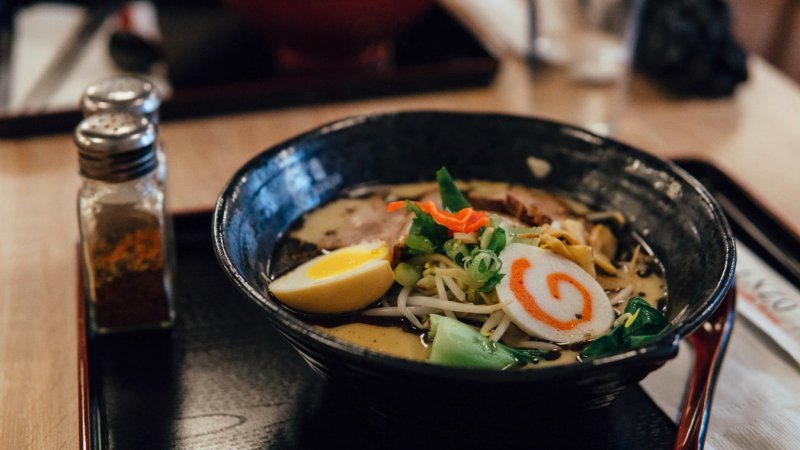
Soba - Buckwheat Noodles
Soba It is a traditional Japanese noodle made from buckwheat that is often served cold or hot. They are easily found throughout Japan, and it is a common dish that replaces the standard meals consisting of rice and meat.
There are different types of Soba, from the most consistent industrialized to homemade made from pure buckwheat which has a super fragile consistency. The noodles usually mix with the sauce of the dish causing a magnificent flavor.
Some characteristics of soba are its crunchy sensation, the way the noodles and the sauce mix and meet on the tongue, as well as its aroma. The most traditional are kakesoba, tenpurasoba, zarusoba (cold noodles), sansaisoba, and many others.
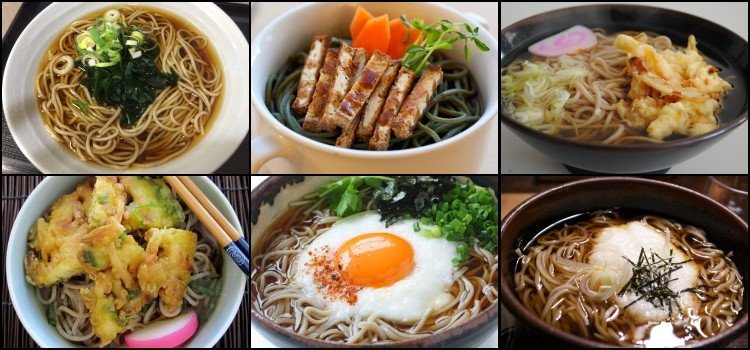
Udon - Thick Noodles
Udon is a thick noodle made from wheat flour. This pasta is usually thicker and whiter than soba, and it also has a broth made from dashi, mirin and shoyu. Usually a Soba restaurant serves the same dishes with Udon noodles.
In other words, there are zaru udon, kake udon, kamaage udon, chikara udon, kare udon, kitsune udon and many others just like there are soba. Udon has a lighter flavor that generally depends on the sauce and the ingredients that accompany it.
While soba noodles are brown, smooth and thin, udon noodles are bright white, round and thick. The flavor and density of udon noodles may vary depending on the region of Japan where you eat them.

Harusame - Transparent Noodles
Harussame, also called glass noodles, is a type of transparent noodles made from starch and water. They are usually sold in dry form, often used in soups, fried dishes or spring rolls.
The harusame is usually made with mung bean starch, potato starch, sweet potato starch, tapioca starch, or canna. In the case of the Japanese version, it is typically made with potato starch. Its name literally means spring rain (春雨).
Translucent noodles are commonly used to make salads, or as an ingredient in hot pot dishes. They are also often used to make Japanese adaptations of Chinese and Korean dishes. Another similar alternative is Shirataki.
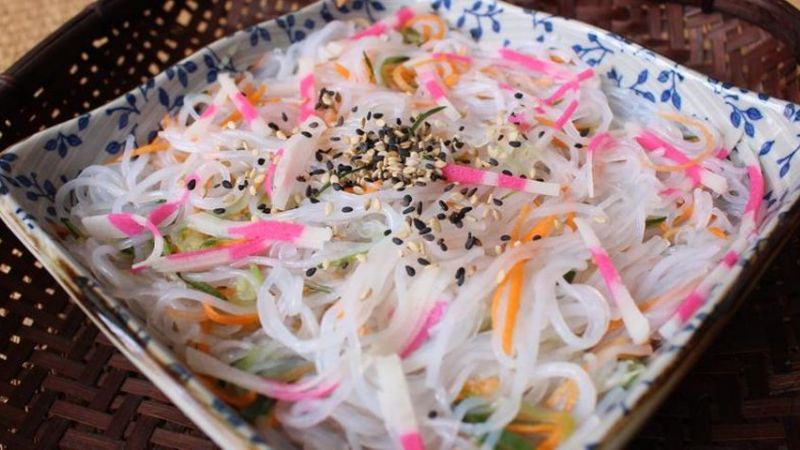
Shirataki - Calorie-free noodles
Shirataki also known as Konnyaku gained popularity outside of Japan as a weight loss food due to the lack of calories. The thin, translucent noodles are made from konjac yam and is rich in dietary fiber, low in carbohydrates and calories.
Noodles are quite popular in sukiyaki, nikujyaga, and other boiled dishes. The noodles can also be drained, dried, and toasted, which reduces bitterness and gives the noodles a consistency, usually used in soup or sauce.
The shirataki noodles can be bought dry or wet. When purchased wet, they are packed in liquid. They usually have a shelf life of up to a year. It is recommended to wash the noodles to remove the odor from the liquid version.

Somen - cold noodles
The somen [素麺] is a very thin white wheat flour noodle, usually served cold and quite popular in the Japanese summer. The same noodle can be served hot in winter by the name of nyumen.
Somen is cooled right after being cooked and is served plain to be dipped in a sauce called tsuyu, which is usually based on katsuobushi with onion, ginger, or myoga. Surprisingly, this cold noodle is really a delight.
Some restaurants offer nagashi-somen. In this occasion, the noodles are placed in long bamboo troughs that float by, at that moment you must be quick, grab the noodles and put them in the sauce. A kind of noodle conveyor.
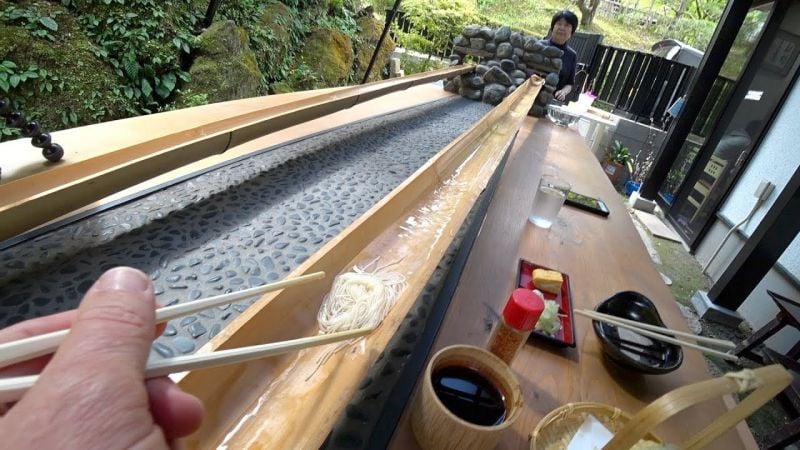
Yakisoba - Fried Noodles
The word Yakisoba literally means "fried noodles." This dish is widely consumed and appreciated in many parts of the world, especially in Brazil. It is a street food, present at festivals and fairs.
Yakissoba is a simple dish, basically made with fried noodles with vegetables and meats. Always well seasoned and with a specific sauce. The Chinese noodles used in yakissoba are called chuukamen, which is similar to lamen.
There are variations like yakiudon made with thick noodles. Yakisoba is so famous and succulent that it is often sold inside a bread at convenience stores called yakisoba pan.

Tokoroten - Seaweed noodles
Tokoroten is a noodle made from agarophyte algae and has been consumed by the Japanese for over a thousand years. Tokoroten is believed to have been introduced to Japan by China during the Nara period, it was widely consumed in the Edo region.
Originally, the pasta was simply made by boiling tengusa and served to eat right away. Through freezing, the emergence of kanten, jelly or agar-agar was discovered. Its firm consistency gave rise to tokoroten noodles.
Tokoroten can be consumed hot or cold. As pasta it is best eaten with a mixture of vinegar and soy sauce, sometimes with nori, pepper and sesame. In the Kansai region, tokoroten is consumed as a dessert with kuromitsu.
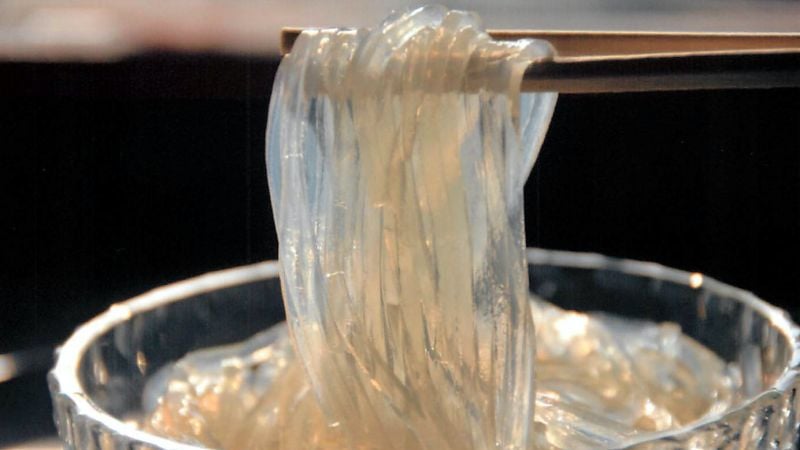
Hiyamugi - Iced Wheat
Hiyamugi [冷麦] means cold wheat, it is a type of dry Japanese noodles, very thin and made of wheat. It is thicker than somen, similar to vermicelli, considered the second thinnest noodle after only.
Hiyamugi are between 1.3 millimeters and 1.7 millimeters in diameter. Anything thicker is udon and anything thinner is sōmen. They are usually white, but can be mixed with pink or green noodles.
Hiyamugi it is appreciated cold during the summer months. It is usually served over ice or floating on water in a clear glass bowl. Chilled noodles are served with a sauce on the side called tsukejiru, made with dashi, soy sauce and mirin.

Chanpon - Noodles cooked in soup
Chanpon is a regional noodle dish from Nagasaki. There are different versions in Japan, Korea and China. The dish was inspired by Chinese cuisine. It is made by frying pork, seafood and vegetables with lard in a soup made with bones.
Macaroni is made especially for chanpon. Unlike other ramen dishes, only one pot is needed as the noodles are cooked together with the soup. Depending on the season, region, and situation, the ingredients differ along with the flavor.
There are other variations found in Japan. Ankake no Chanpon is a soybean sauce-based variant found in Tottori, Shimane provinces, as well as in the city of Amagasaki, Hyōgo Prefecture.
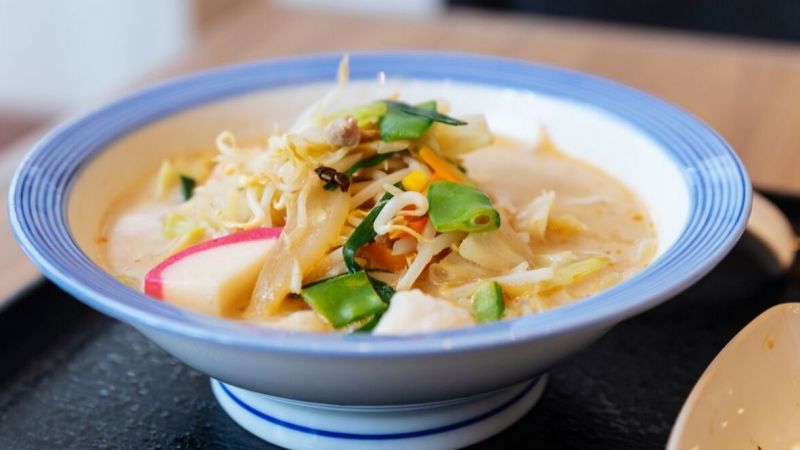
Instant Noodles - Cup Noodles
Instant noodles and the famous Cup Noodles were invented in 1958 in 日本 by Momofuku Ando, founder of Nissin. One of the most consumed pastas worldwide, in 日本 there are thousands of flavors and different types of instant noodles.
Instant noodles are consumed by a large part of the Japanese and world population, due to the low price and short preparation time. Called ramen, its flavor doesn't even come close to an original ramen.
Despite being tasty, it is rich in fat, sodium and several chemical components, which can be bad for your health if consumed too often. Nowadays all countries manufacture their instant noodles.
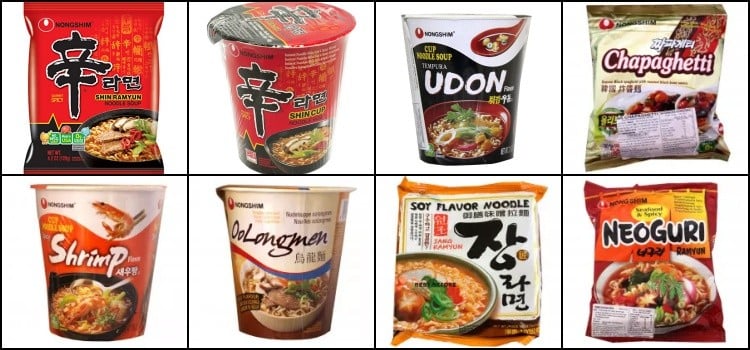
Other types of Japanese noodles
Sanuki udon – Popular in Kagawa, it has its unique characteristics, the noodles have a square shape and flat edges with a very chewy texture. This type of udon can be found in restaurants written [さぬき].
Wanko Soba – A style from Iwate Prefecture, particularly in Morioka and Hanamaki. It consists of a small portion of soba noodles in small bowls. Where you quickly eat your soba noodles and refill your bowl right away.
Sara udon - Literally means "plate noodle," it is a native dish from Nagasaki prefecture. Despite the name Udon, there are variations with thin noodles that are quite popular. The noodles are served with fried cabbage, moyashi, vegetables, pork, and others.
Okinawa Soba – A type of noodles made in Okinawa, its pasta is not like the original soba, it is more like udon and your soup reminds me a lot ramen, the dough may come out slightly flattened depending on the region in Okinawa.
Toshikoshi soba – Traditional Japanese noodle dish eaten on New Year's Eve. This custom leaves the hardships of the year behind because plain buckwheat soba noodles are easily cut when eating.
Tsukemen – A very strong type of ramen with thick broth where you actually dip the noodles in the broth to eat it. Soba and udon are some types of noodles used in the dish.
Wafu Pasta - Italian Pasta in Japan
In Japan, just like the rest of the world, you can find traditional Italian pastas and other regions of Europe. Western recipes like carbonara are quite popular in Japan. I personally experienced these pastas thanks to Japan.
There are restaurant franchises like saizeriya specialized in pasta similar to Italian dishes, but adapted to the Japanese palate. Pizzas and other types of pasta are quite common in Japan.
There is a fusion of Italian pasta and Japanese pasta called Wafu Pasta. Just as you can find authentic Italian recipes in Japan, you can also find traditional pasta like spaghetti in Japanese recipes.
The origin of Wafu dough dates back to 1953 in a small restaurant in Tokyo called Kabenoana (Hole in the Wall). At the time, there were only three restaurants serving pasta in Tokyo, one of which was in the Imperial Hotel.”
Italian pasta is usually called pasta, which literally refers to dough. It is also commonly used to refer to the variety of pasta dishes. In Japanese, pasta is called men [麺].
Typically, dough is made from an unleavened dough of durum wheat flour mixed with water and formed into sheets or various shapes. It can be made with flour from other cereals or grains, and eggs can be used instead of water.
Japanese pasta vocabulary
In addition to the types of Japanese noodles we've seen throughout the article, you may want to try other Italian pasta and pasta dishes. Below we will leave a list of words referring to types of noodles in Japanese.
| Portuguese | Japanese | Romaji |
| thick noodles | 太麺 | futomen |
| egg paste | エッグパスタ | eggupasuta |
| angel hair | カペッリダンジェロ | kaperridanjero |
| Thin pasta (fettucine) | 平麺 | hiraman |
| capellini | カッペリーニ | kapperiinii |
| vermicelli | バーミセリ | beemiseri |
| carbonara | カルボナーラ | karubonaara |
| fedeline | フェデリーニ | fuederiini |
Where to buy Japanese noodles?
After seeing these delights, you may wonder where to buy and eat these noodles. If you are in Japan, just go to any street to find a market or restaurant, since those who live in Brazil have some difficulty finding them.
In Brazil it is common to find yakisoba, udon and ramen, but even a simple and traditional buckwheat soba is hard to find. Some manage to buy such pasta in markets with an oriental products section.
Unfortunately, these supposed industrialized Asian noodles sold in the market are not the same as the true noodles found in 日本. Many are manufactured in Brazil and only imitate the real noodles found in Japanese restaurants.
List of Chinese Noodles
Japan and China have a great connection, so it is quite common to find Chinese pasta in Japan, both in Japanese versions and in its original Chinese version. To complement the article, let's leave a list of Chinese noodles:
Sometimes the name below just refers to the ingredient in the Chinese pasta mix. It is a popular and common dish. I hope you enjoyed the article, if you liked it share and leave your comments.
- Ants climbing a tree
- Banmian
- Beef chow fun
- card
- Chongqing
- Chow mein
- Atravessando a ponte
- Kuan fen
- Dan zai
- Dandan
- Drunken
- Hokkien mee
- Quente e azedo
- Hot dry noodles
- Lanzhou beef lamian
- Liangpi
- Lo mein
- Lomi
- Huoguo dun fen
- Luosifen
- Mee pok
- milinge
- Satay bee hoon
- Shanghai fried
- Su-style
- Ulmyeon
- Wonton
- Yuntunmian
- Zhajiangmian
- Biangbiang
- Cellophane
- Tampa da panela de Chinkiang
- Cumian
- Daoxiao
- dragon bear
- Henan braised
- "Quente e seco"
- Jook-sing
- Kaomianjin
- Lai fun
- Lamian
- Liangpi
- Migan
- Misua
- Mixian
- Folhas de feijão mungo
- Oil
- Paomo
- Ramen
- Rice vermicelli
- Saang mein
- Shahe fen
- Shrimp roe
- Silver
- Yi mein
- Youmian
- Gong Zai Mian
- Wonton noodles
- Cheonsachae
- Dotori guksu
- Garak guksu
- Jjolmyeon
